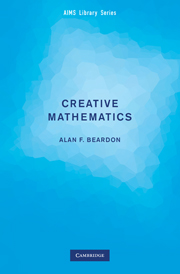24 - Problem I: Discussion and Generalisations
Published online by Cambridge University Press: 16 May 2024
Summary
The Theorem in Part II is easy to prove by showing that bc + 1 = (b + q)2 and ac + 1 = (a + q)2. Not every Diophantine triple arises in this way; for example, (1, 3, 8) and (1, 3, 120) are both Diophantine triples and at least one of these cannot be of this form.
Let us consider the problem of extending a Diophantine pair (a, b), where a and b are coprime and ab + 1 = q2, to a Diophantine triple (a, b, c). We have to find positive integers c, X and Y such that ac + 1 = X2 and bc + 1 = Y2. If there is a c such that (a, b, c) is a Diophantine triple then X and Y exist and are solutions of the Diophantine equation bX2 − b = aY2 − a. Conversely, if X and Y are solutions of this equation, then a divides X2 − 1 (because a and b are coprime), and b divides Y2 − 1, so we can define c by c = (X2 − 1)/a = (Y2 − 1)/b, and then (a, b, c) is a Diophantine triple.
We can use this argument to make a reasonably efficient computer search for those values of c forwhich (a, b, c) is a Diophantine triple (by searching for solutions X and Y of bX2 = aY2 + b − a). This gives, for example, the following Diophantine triples:
Note that this shows that many Diophantine triples (a, b, c) can be found with the same a and b but with different c.
Fermat was the first person to find a Diophantine 4–tuple, namely (1, 3, 8, 120), and (much later) Baker and Davenport (and subsequently others) showed that if (1, 3, 8, d) is a Diophantine 4–tuple, then d = 120 (but this is not easy). No Diophantine 5–tuple (of integers) is known; however, (777480/8288641, 1, 3, 8, 120) is a Diophantine 5–tuple of rational numbers.
- Type
- Chapter
- Information
- Creative MathematicsA Gateway to Research, pp. 99 - 102Publisher: Cambridge University PressPrint publication year: 2009

